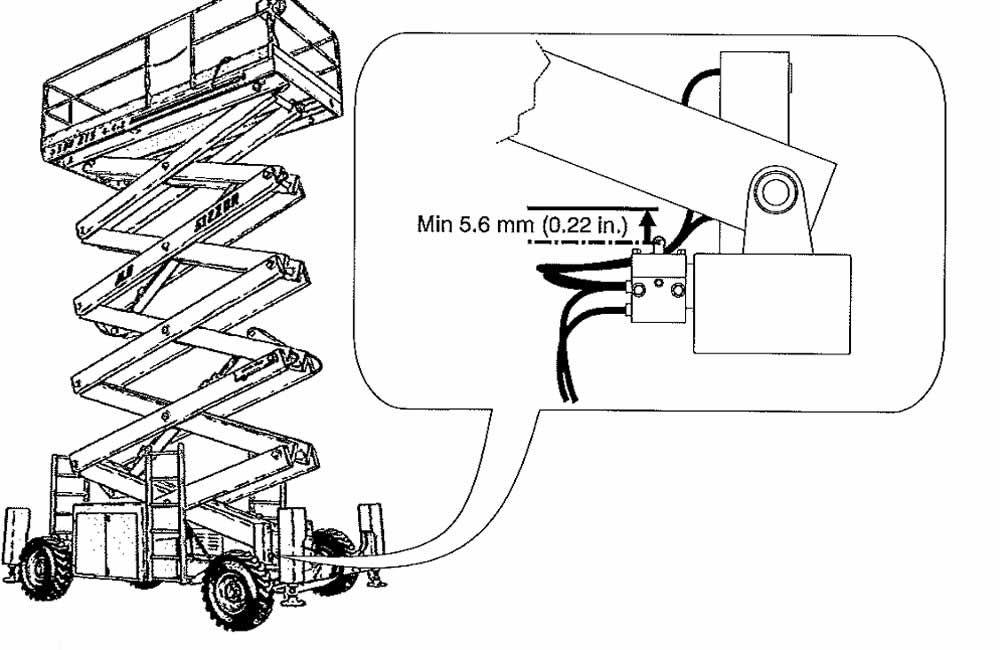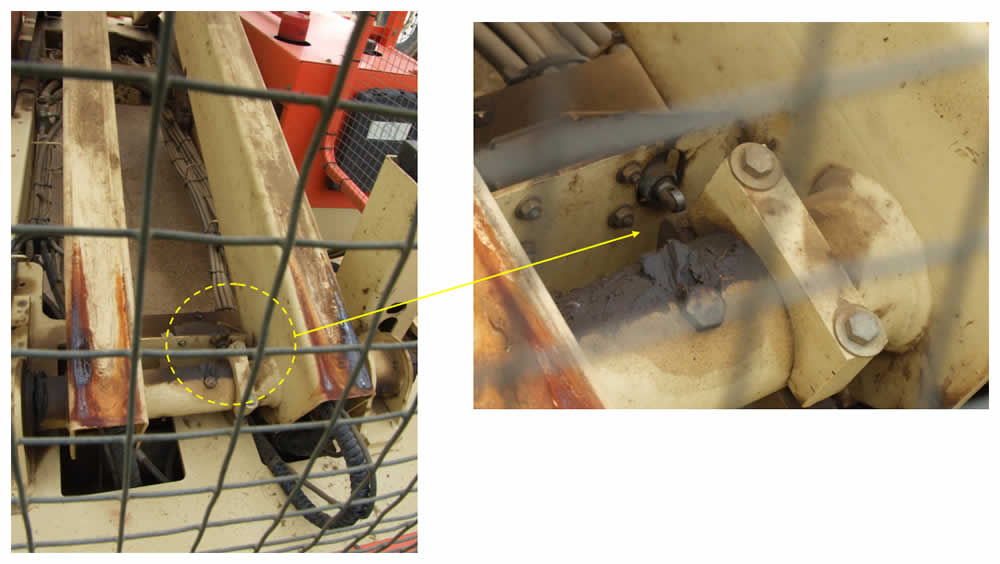Overturns of JLG 500RTS scissor lifts
Health and Safety Executive - Safety alert
Department Name:
Field Operations Directorate
Bulletin No:
FOD 1-2011
Issue Date:
5 January 2011
Target Audience:
Owners and operators of JLG 500RTS and 400RTS scissor lifts.
Leasing companies; service and maintenance engineers; Construction Industry; competent persons and Inspection Bodies; who work with JLG 500RTS and 400RTS scissor lifts and other Mobile Elevating Work Platforms (MEWPs).
Key Issues:
Maintenance, inspection and function testing of both oscillating axle lockout valves and the lift/drive interlock system on JLG 500RTS and 400RTS scissor lifts (and any other MEWPs with similar interlock systems).
Introduction:
The purpose of this Safety Alert is to alert the target audience above about the need to regularly maintain, inspect and test (as recommended by manufacturers, and as required by law), safety related equipment on Mobile Elevating Work Platforms (MEWPs) generally, and also specifically to remind owners, users and others involved in the use of JLG 500RTS and 400RTS scissor lifts, of this need (scissors lifts are a type of MEWP).
This Alert also highlights to the target audience, the requirement to follow the specific instructions for daily inspection and function testing outlined in the current Operation and Safety Manual for JLG Model 500RTS and 400RTS scissor lifts. Failure to follow the instructions contained within the Operation and Safety Manual can result in serious or fatal injuries.
The target audience are also reminded that it is vital not to operate MEWPs, in general, if systems designed to maintain safe operation are damaged, overridden or not working.
The Information in this Safety Alert may also be relevant to other makes or models of MEWPs that incorporate similar oscillating axle lockout valves or lift/ drive interlock systems.
Background:

The JLG 500RTS scissor lift is equipped with an oscillating axle which allows the machine to be driven on uneven ground with the platform in the transport position. JLG 400RTS models have a similar design of oscillating axle lockout valve (and lift/drive limit switch). As soon as the platform is raised out of the transport position (by the scissor arms being raised off the chassis), the oscillating axle should lock preventing further rotation of the oscillating axle. This functions by a plunger valve (the oscillating axle lockout valve) mounted on the chassis being released under spring pressure, preventing further rotation of the oscillating axle. The position of the oscillating axle lock out valve is shown in figure 1.
The scissors lift is also equipped with a lift/drive cut out limit switch (figure 2) which both

- prevents the platform being lifted above 6.7m unless the stabilisers are deployed (with the 400RTS scissors lift the lift/drive limit switch should prevent the platform from being raised above 8m), and
- prevents the MEWP being driven if the platform is above 6.7m (or 8m if the 400RTS), or when the stabilisers are deployed.
Following a review by HSE into the circumstances of three fatal accidents within a 4 year period in Europe, all of which involved the overturn of a JLG 500RTS scissors lift, it has been established that in all three cases:
- the oscillating axle lockout valve failed as the platform was raised, and,
- the lift/drive interlock system did not work allowing the platform to be elevated above 6.7m without the stabilisers being deployed. In addition, in at least one of the three overturns, the scissors lift was also driven with the platform above 6.7m which should not be possible.
In each of the three cases this resulted in the MEWP becoming unstable in use, and the scissor lift overturned killing the occupants.
In two of the three overturns the oscillating axle lockout valve plunger was found to be seized in the down position as a result of corrosion products. In the third incident, the oscillating axle lockout valve switch was described as being stuck and non-operational.
In one of the three overturns, the lift/drive limit switch (part of the interlock system) may have been deliberately defeated, in another the lift/drive interlock system failed for reasons that were not established, and in the third case the roller cam assembly on the limit switch may have been loose.
JLG have issued two field service bulletins, FSB#2-12-01 (in 2002) and FSB#108A3E (in 2008) which required owners of affected machines to (i) install a new cam for the lift/drive limit switch and (ii) inform owners of revised checking procedures for the machine respectively. It is important that owners of affected machines ensure that these two Field Service Bulletins have been actioned and, if necessary, that their machines have been modified as described in FSB#2-12-01 and that suitable testing and inspection regimes are in place. FSB#2-12-01 affected certain JLG Models 400RTS and 500RTS scissor lifts shipped prior to November 26 2002 (see bulletin for a list of affected units). FSB#108A3E affected JLG 400RTS and 500RTS Scissors lifts equipped with Operator's and Safety Manual #3120828.
The correct inspection procedure can be found in Section 2-5 of the Operation and Safety Manual (See further information in Action required section).
In each of the 3 incidents the machines were being either inspected, examined or tested at the time, however, HSE considers that the information in this Alert is relevant to all the Target Audience, not just those involved in inspection, examination or testing.
Action required:
- Owners of JLG 500RTS and 400RTS scissors lifts should ensure that the oscillating axle lockout system and the lift/drive cut out switches are checked for correct functioning (in accordance with the manufacturer's recommendations) before the machine is next used, and thereafter, as advised by the manufacturer.
- It is critical that users of JLG 500RTS and 400RTS scissors lifts complete daily inspections and function testing of the oscillating axle lockout system and the lift/drive limit switch in line with the manufacturer's recommendations contained in Section 2.5 of the Operation and Safety Manual. Failure to undertake daily tests and inspections can result in safety critical faults going undetected and lead to potential for the MEWP to overturn resulting in serious of fatal injuries
- Owners and operators of JLG 500RTS and 400RTS scissors lifts should ensure that the equipment has been inspected and examined and complies with JLG service bulletins FSB#2-12-01 and FSB#108A3E. Competent persons, inspection bodies and others involved with JLG 500RTS and 400RTS scissors lifts should be aware of the contents of these 2 JLG service bulletins.
- JLG Field Service Bulletin FSB#108A3E requires owners of affected machines to obtain an updated Operator's and Safety Manual numbered #3120828 for JLG Models 400RTS and 500RTS Scissor Lifts. A list of machines affected by FSB#108A3E is given in the bulletin. Operator's and Safety Manual numbered #3120833 is not affected by the update described in FSB#108A3E.
- FSB#108A3E describes (for owners of affected machines) a revised Section 2 of the Operator's and Safety Manual which includes additional inspection criteria in the daily function check for the axle lockout valve switch on machines equipped with oscillating axles.
- A current Operator's and Safety Manual should be kept with the machine
- JLG's Operations and Safety Manual can be found at the JLG website by following the link to Safety and Product Manuals. Field Service Bulletin information is available to all JLG account holders through an Online Service System. Other owners can contact their local JLG Sales and Service Organisation who will be able to deal with their enquiry.
- It is important that persons carrying out function testing of JLG 500RTS and 400RTS scissors lifts should do this from the ground using the ground controls first before using the platform controls. Generally, where possible, testing of safety critical functions should always be carried out using ground controls first (where the operator is at lower risk) before carrying out tests from the platform.
Relevant legal documents:
- Lifting Operations and Lifting Equipment Regulations 1998
- Provision and Use of Work Equipment Regulations 1998
References:
- Field Service Bulletin reference: FSB#2-12-01. Subject: Update of Leveling Jack Interlock
- Field Service Bulletin reference: FSB#108A3E. Subject: Revised Operator's and Safety Manual
- Operation and Safety Manual Models 400RTS and 500RTS
Further information:
JLG Industries Inc. (Europe)
Wright Business Centre
1 Lonmay Road
Queenslie
Glasgow G33 4EL
Scotland
United Kingdom
Phone: +44 (0)141 781 6700
Product Safety and Reliability Department
JLG Industries Inc.
13244 Fountainhead Plaza
Hagerstown, MD 21742, USA
Phone: +1 240 420 2661
Email: [email protected]
Subscribe for free health and safety news and updates on this topic.